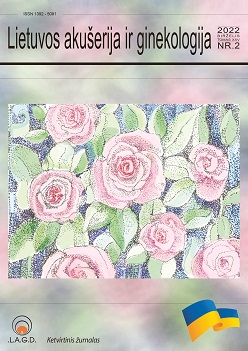INFLUENCE OF GESTATIONAL DIABETES ON NEWBORN’S BREASTFEEDING IN THE HOSPITAL AND IN THE FIRST MONTH OF LIFE
Abstract
Objective. To evaluate newborns whose mothers have gestational diabete breastfeeding in the hospital and in first month of life. Methods. A prospective study at Hospital of Lithuanian University of Health Sciences Kauno klinikos. Medical records of 126 healthy full-term newborns who were born between 2021 October 1st – December 31st by nulliparous mothers with or without gestational diabetes mellitus were analysed. Newborns were divided into two groups: mothers with gestational diabetes mellitus (GD-) and mothers without it (GD-). Data on neonates feeding after birth was collected from the medical documentation “Naujagimio raidos istorija”. Mothers’ telephone surveys 1 month after delivery were performed to evaluate breastfeeding and related difficulties. Statistical analysis was performed using IBM SPSS 26.0 version. Results. 40.5 % of mothers were GD+, 59.5 % of mothers were GD-. On 1st day in the hospital, most neonates in the study group were exclusively breastfed (83.6 %), we did not find a significant difference between GD+ and GD-. On 2nd second day, GD+ group neonates were significantly less likely to be breastfed (62 %) and more likely to be fed with formula (F) (38 %) than GD- (respectively 81.3 % and 13.3 %) (p = 0.002). GD+ group infants were more likely to need F 4 weeks after birth than GD- (p = 0.042). GD+ newborns who required supplementation in the hospital were significantly more likely to be fed exclusively with F and less likely with breast milk (BM) (p = 0.008). The supplementation device (bottle or breastfeeding-friendly devices) had no significant effect on the frequency of breastfeeding. The most common reason for supplementation at the hospital (64.3 %) and 4 weeks after birth (63.6 %) was insufficient milk production. GD+ group discontinued breastfeeding significantly more often due to damaged nipples. Conclusions. GD+ neonates were significantly more likely to be fed exclusively with F and significantly less with BM on the 2nd day and 4 weeks of age. At 4 weeks of age, F/F+BM was significantly more likely to be fed to infants who had supplementation or were fed using a bottle after birth. However, supplementation in the hospital,not means of feeding, had a significant effect on GD+ using F more frequently at 4 weeks of age. GD+ mothers reported painful / damaged nipples significantly more often than GD- as a reason for discontinuation of breastfeeding.

